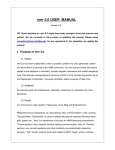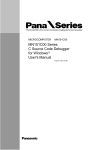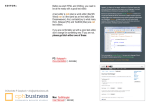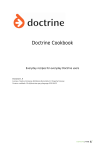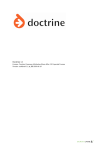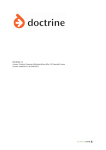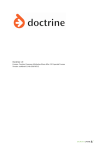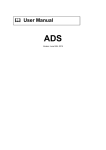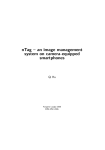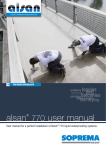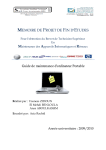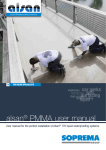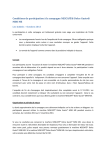Download developing web blog system for developer`s helsinki oy
Transcript
BACHELOR‟S THESIS Degree Programme in Business Information Technology Business Information Systems Management 2011 Prince Akyereko DEVELOPING WEB BLOG SYSTEM FOR DEVELOPER’S HELSINKI OY BACHELOR´S THESIS | ABSTRACT TURKU UNIVERSITY OF APPLIED SCIENCES Business Information Technology | Business Information Systems Management 2011| 66 Paivi Nygren Prince Akyereko DEVELOPING WEB BLOG SYSTEM FOR DEVELOPER’S HELSINKI OY This Bachelor‟s thesis project is about web blogs and developing one with MySQL and PHP. The blogging system was built for Developer‟s Helsinki Oy. Gathering the user requirements was done through reading of the documentation accompanying the project, reading the manuals of the older blog system and interaction with other developers and owners of the project. The goal was to build a web blog system for the users to send, read and comment on posts. The blog was built with PHP, CSS, MySQL, JavaScript, and HTML. It has both the administrator‟s and the registered users‟ interfaces. The system was tested on the most common browsers. KEYWORDS: Weblog, PHP, MySQL TABLE OF CONTENTS LIST OF ABBREVIATIONS 1 INTRODUCTION 7 2 BACKGROUND 10 2.1 Advantages of Blogs 11 2.2 Disadvantages of Blogs 13 2.3 Making a Blog 13 3 WEB BLOG FOR DEVELOPERS HELSINKI OY 16 3.1 The current system and Problems Associated with It 16 3.2 Gathering User Requirements 16 3.3 Building the Application Process 18 4 HOW THE SYSTEM WORKS 25 4.1 Creating Really Simple Syndication (RSS) Feed for the Blog 37 5 TESTING THE APPLICATION 38 5.1 Layout Testing 38 5.2 Functional Testing 42 6 SUMMARY 47 SOURCE MATERIAL 49 APPENDICES Appendix 1 Application Codes 50 Appendix 2 Other UML Diagrams of the system 64 SCREENSHOTS Screenshot 1: Login page 24 Screenshot 2: Sign up form 26 Screenshot 3: Writing post in the system 29 Screenshot 4: After submitting post in the system 30 Screenshot 5: Updating post in the system 31 Screenshot 6: After submitting update post in the system 32 Screenshot 7: A visitor (registered) writing comment on a post 34 Screenshot 8: After visitor (registered) called “peter mensah” has submitted his comment on a post 35 Screenshot 9: Searching for post result in the system by a visitor called “kojo” 36 Screenshot 10: Layout testing in internet explorer 39 Screenshot 11: Layout testing in Google chrome 39 Screenshot 12: Layout testing in Firefox 40 Screenshot 13: Layout testing in Safari 41 Screenshot 14: Layout testing in Opera 41 Screenshot 15: Update post in Internet explorer 43 Screenshot 16: Compose form in Internet explorer 43 Screenshot 17: Compose post form in Safari 44 Screenshot 18: Updating post in Opera 44 Screenshot 19: Testing the search button and results n Opera 45 Screenshot 20: Post selection and comment form on Google chrome 45 Screenshot 21: Post comment form and post selection in Safari 46 FIFURES Figure 1: Figure 1: Tables of the blog database 19 Figure 2: Use case diagram of the Developers blog system 20 Figure 3: Activity diagram of adding new post 22 Figure 4: Activity diagram of commenting on blog post 23 Figure 5: Use Case description and scenario of commenting on added post 24 Figure 6: Briefly descriptions of roles perform by registered users in the system 27 Figure 7: Account Creation Use Case and Description 64 Figure 8: Activity Diagram of Creating User Account 65 Figure 9: Flagging and banning inappropriate Comment 66 TABLES Table 1: Event Table of the Blog System 21 Table 2: Layout testing 38 Table 3: Functional testing 42 Table 4: Compose Post Form (HTML) 50 Table 5: Sending Post into the Database (blog_post.php) 51 Table 6: PHP Code that lists all posts on the Page (listing_post.php) 52 Table 7: Commenting on post code 53 Table 8: Deleting Post 54 Table 9: HTML and PHP code that creates the Blog Home page (index.php) 55 Table 10: XML FEED FILE (blogfeedindex.xml) 57 Table 11: CSS File for the Application. (css_blog.css) 58 Table 12: Blog Home Pages (HTML) 62 Table 13: Headers and Footers. It has both header.php and footer.php 63 LIST OF ABBREVIATIONS HTML Stands for Hyper Text Markup Language. A markup language is a set of markup tags. HTML uses markup tags to describe web pages (W3school Group, 1999-2010.) PHP Stands for Hypertext Pre-processor, is a server-side scripting language and scripts are executed on the server (W3school Group, 1999-2010). CSS Stands for Cascading Style Sheet (W3school Group, 19992010). JavaScript Was designed to add interactivity to HTML pages and is a scripting language (W3school Group, 1999-2010) ASP Stands for Active Server Pages and is a Microsoft Technology that runs inside the IIS (W3school Group, 19992010) MySQL is an open source relational database management system based on the Structured Query Language (SQL)( W3school Group 1999-2010). 7 1 INTRODUCTION The invention of the internet in the 19th century paved way for many ways of communication. Websites are integral part of communication in our everyday online activities. Nowadays with the availability of internet in every home blogging is becoming more and more popular. Today blogs and other websites have become a source of information for many people and organizations all over the world. Schools, government and private organizations, journalists, news houses etc. all depends on a web blog system to tell us the information that we need and inspire us to visit their web pages every day. (Wikimedia Foundation, Florida, USA, 2010.) Therefore, there should always be an easy way anybody can post and edit something into a website that they have right to without needing to edit the programming code. Without a web blog system being incorporated in a web page, it is always going to be difficult for people to post and add information to their websites everyday. This project focuses on building a web blog system from the scratch for Developer‟s Helsinki Oy using HTML, CSS, PHP, MySQL, JavaScript etc. MySQL was the database server used to store the blog posts and PHP was the scripting language used to put content into the database and bring it back into the weblog. The building of the application began by reading the project documentation submitted to me by the company and a personal discussion with the project manager and other developers. The project shows a way of designing a blog that will be user friendly and allows its visitors to be part of the system. The visitors who read the posts will be allowed to contribute and comment on the posts and their comments will be available to the entire audience. The system was designed in two phases. There is the administrator interface and the home page for the blog posts to appear for the visitor. The administration site allows the administrator to post and edit blog posts. Moreover, it allows him/her to list the posts and delete any TURKU UNIVERSITY OF APPLIED SCIENCES THESIS / Prince Akyereko 8 post that is no more relevant and must be removed from the system. The administrator interface is where the blog post is composed before it can be posted to the home page for the visitors to see. The home page for the blog is where the most recent posts are shown. It also has the search facility and archives area where the older posts can be seen. The part of the blog that invites the visitor or the user to be part of the system by contributing and leaving comments motivates and attracts some people to visit the page. There is also the Really Simple Syndication (RSS) feed for the blog. The RSS feed is a way in which websites distributes their contents. ‘An RSS feed is an XML file that tells the outside world when you have updated your blog so your readers do not need to keep coming back to your website to find out whether you made any changes. It defines an easy way to share the website updates, headlines and news to regular customers who has subscribed to the RSS feeds of the website‟. (Andy Budd et al., 2006, 329.) In designing the system, the developer has taken into consideration the needs of the final user and how the user will interact with the system. The user and the company‟s requirements are those implemented here with the view of achieving the client‟s needs. Every technology used in this project is by the request of the customer. A database of the blog and other tools used in the system conform to the contemporary design rules of the company. In the future, the blog could be modified and improved to have more functions with time. A feature could be added which will allow one to post and preview his post in the administrator area before they are finally posted onto the blog. In addition, the same preview section could be added to the comments area also. Moreover, in the future, other ready made tools such as Textile and Markdown could be added to the blog to allow good and more advanced formatting. It is possible to add categorization system to the blog posts which will allow the posts to be categorized A sample of people was selected to test the system and give feed back. Developer‟s Helsinki Oy has acknowledged the system and has implemented it TURKU UNIVERSITY OF APPLIED SCIENCES THESIS / Prince Akyereko 9 and customer feedback has also been encouraging. TURKU UNIVERSITY OF APPLIED SCIENCES THESIS / Prince Akyereko 10 2 BACKGROUND Blogging kicked off big style in 2004. It was around for quite a few years before that, but not really mainstream. The word “blog” certainly couldn‟t be found in the pages of a dictionary and was only used in conversations online, by those who were “in the know”. These days, you hear it everywhere. (Andy Budd et al., 2006, 5.) A blog is website mainly maintained by an individual with regular entries of articles, descriptions of events, or other materials such as photography, art or other media files (Andy Budd et al., 2006, 3). A blog is a personal website that provides updated headlines and news articles of other sites that are of interest to the user; also may include journal entries, commentaries and recommendations compiled by the user; also written web log, weblog; also called blog (Andy Budd et al., 2006, 2). Again, a blog often call weblog is a type of website, normally maintained by an individual with regular entries of articles, descriptions of events, or other materials such as photography, art or other media files. Posts are frequently exhibited in a reverse dated order. Blog can also be used as a verb, meaning to update or add content to a blog. (Wikimedia Foundation, Florida, USA, 2010.) Majority of blogs are interactive, allowing visitors to post comments and even message each other through gadgets on the blogs and it is this interactivity that differentiates them from other static websites. So many blogs provide a written explanation on a particular theme; others function as more personal online log. A typical blog combines text, other inputs, images, and links to other blogs, websites, and other communications related to its subject. Today, the ability of readers to post comments in an interactive way is an integral and essential part of many blogs. A lot of blogs are mainly textual, notwithstanding some blogs focus on music (MP3 blog), art (Art blog), videos (video blogging), audio (podcasting), and photographs (photo blog). There is another type of blogging which give prominence to very short posts. This way of blogging is called Micro TURKU UNIVERSITY OF APPLIED SCIENCES THESIS / Prince Akyereko 11 blogging. (Wikimedia Foundation, Florida, US, 2010.) Again, a blog can also be described as a website that allows users to reflect, give opinions, and talk about various subjects in the form of an online journal while readers may comment on posts. Posts usually appear in a reverse sequential order. (Mediawiki, Creative Commons Attribution-Share Alike, 2002.) Apart from those types of blogs mention above which are mainly categorized by the media type, there are other different types of blogs which needs to be mentioned. Among of these, the differences are seen based on the way or the purpose in which the blog is used for. Some blogs are use for personal purpose while others are for political reasons and other reasons (Wikimedia Foundation, Florida, US, 2010). Personal blog is normally a commentary by a single person and is the most traditional and a regular form of blog that exists. There are also corporate and organizational blogs. These are blogs used or written internally to enhance the communication and a way of life in an organization or outside for public relations or advertising and selling purposes. (Wikimedia Foundation, Florida, US, 2010.) A blog on the other hand can also be categorized by a genre. Normally, this type of a blog is written purposely with a focus on a particular subject such as political blog, educational blog, and legal blogs. (Wikimedia Foundation, Florida, US, 2010). A web blog with shorter entries and blend media type is called tumble log. A blog that is written on typewriters and then scanned is called typecast. Also a blog can be described by the device being used to send or to compose it. A blog written by a mobile device like a mobile phone is called a mob log. (Wikimedia Foundation, Florida, USA, 2010.) 2.1 Advantages of Blogs The basic advantage of having a blog is to enable a user to share their views TURKU UNIVERSITY OF APPLIED SCIENCES THESIS / Prince Akyereko 12 and opinions about a particular topic. On the hand, a unique feature of a blog is the ability to let registered users comment on what they read. This lets interested individuals discuss that particular topic. This leads to further exchange of information and ideas. (Wetzel, 2010.) There are quite a few major blog hosting sites that offer various features that enable users to determine how they wish to express their opinions. For example, a blog hosting site may offer various different templates which would make it attractive or perhaps try to make creative parallels between the writer's ideas. (Wetzel, 2010.) This unique display style implemented by the blogger creates a persona that attracts like minded individuals, thus creating a sense of community with dissemination of interesting information. In essence, blogs are easy to maintain because they are organized in chronological order. For example, a reader would be able to access a blog according to time if they wish, or they can search with respect to the topic titles. (Wetzel, 2010.) An important thing to note about blogs is that they are easy to edit as well. That is because the only thing required is login information and access to internet. This makes it easy for bloggers to express their views wherever they may be. (Wetzel, 2010.) Another significant advantage of blogs is that it lets users share their views when they might not be given a voice due to selectiveness of other media (such as newspapers, magazines and other forms of publications) (Wetzel, 2010). That is because these print media have limited capacity and they must choose what might be in the best interest of their organization, hence the selectiveness. On the contrary, in the blogosphere there is virtually no limit as to how much and how well one would like to express his/herself. As a result, people choose to express their feelings and views on the blogosphere depending on what they feel like sharing. (Miller & Pole, 2010.) Interestingly though, blogging also creates an opportunity for bloggers to be picked up by news media as a supplement to their news stories. For instance, when the iPhone was leaked, all the anticipated information was acquired from the Gizmodo technology blog. As a result, Gizmodo enjoyed the fame that it probably would not have been able TURKU UNIVERSITY OF APPLIED SCIENCES THESIS / Prince Akyereko 13 to, if it had contacted a news outlet. (Chen, 2010.) Financially, blogging can increase a firm‟s return on investment by having people blog about topics that concern the firm (Miller & Pole, 2010). For instance Developers Helsinki Oy would be able to get a better insight as to what concerns the general public when it comes to designing a system. Blogging would also enable them to understand the demographics of their customers and the systems they seek out. With this vital information, they can then re-design their business processes in such a way that would give them a competitive advantage. Moreover, it would also create a sense of affiliation—where the users would gladly be associated within the market place. 2.2 Disadvantages of Blogs The main product of blogging is the spread of information. When individuals talk about a particular topic, they tend to get into a discussion highlighting the benefits and risks associated. Therefore, the most harmful thing to come out of a blog discussion is negative publicity of a particular product. For example, if one is discussing a health product and someone makes a comment about the side effects, the comment could potentially harm subsequent sales of that particular product. (Wetzel, 2010.) Another disadvantage of blogging is that people might disguise themselves as an expert. This can cause people to believe in false information and might even cause health related damages. Therefore, it is good to keep track of every blog post. Since that would be very difficult, it would be appropriate to allow users to report inappropriate posts and comments. 2.3 Making a Blog A web blog like any other website can be programmed using a lot of modern day web technologies. It can be programmed with HTML, CSS, JavaScript, PHP, HTML, CSS, ASP, Python etc and even with XML. On the other hand, a blog can be created without the need to know any of the above web applications and how to code. Today building sites such as Movable Type, TURKU UNIVERSITY OF APPLIED SCIENCES THESIS / Prince Akyereko 14 ExpressionEngine, WordPress, and Textpattern have made it much easier for someone who does not know coding could even create a blog without any problem. These tools are also good platform to create a very good user friendly and an interactive weblog. (Acroterion, 2001-2007.) There are different ways one can create or design web blog depends on the person‟s requirements and how it wants the blog to be. A blog could be a dynamic one or static depending on the way is programmed and how it functions. The choice between dynamic and static when building a web blog is a critical one that needs to be talked about and must always be taken into consideration when making such a project. (Acroterion, 2001-2007.) Dynamic websites normally provide the visitor or the user with the ability to interact with the content and give some form of feedback. However, the reason for calling these sites dynamic has to do with how the sites are developed and maintained. In the dynamic web site, all of the content, styling files and related web documents are contained within one or more databases located somewhere on the Web and normally administered by an application called a Content Management System. (Acroterion, 2001-2007.) The content is cascaded on the website using various templates written in a dynamic mark-up language such as PHP, JAVA, and ASP. These languages are like HTML, but they are more complicated and can do a great number of things than common HTML. Creating pages dynamically allows for all sorts of intelligent applications, from e-commerce, random quote generators to full on web applications such as Facebook, Twitter and MSN. (Acriterion, 2001-2007.) Static weblog or website on the other hand is one that its pages are stored on the server in the format that is sent to a client web browser (Acroterion, 20012007). Normally, it is designed in simple HTML and does not use server side languages like PHP, ASP, Python and other languages available in its application building. Usually static websites display the same information to its visitors most of the time. (Acroterion, 2001-2007.) This project seems to be one of the dynamic blogs around because it allows the TURKU UNIVERSITY OF APPLIED SCIENCES THESIS / Prince Akyereko 15 user to interact with blogger by posting comment thus making it interesting for the user to visit the site all the time. The administrator can also remove a dangerous or abusive user from the system. TURKU UNIVERSITY OF APPLIED SCIENCES THESIS / Prince Akyereko 16 3 WEB BLOG FOR DEVELOPER’S HELSINKI OY Developer's Helsinki was founded in January, 2009 to develop, test and market great communication ideas. It is a small company operating in the Helsinki region. „The company aims to create intelligent and user-friendly websites and services, which bring real value to our customers. Our goal is to play a central part in the next generation of web-based innovation. That is why we research and develop various projects, which give us insight and tools whereby we can create a great web presence for our customers‟ said by Harry Alanen, co-founder of the company. (Developer‟s Helsinki Oy, 2010.) 3.1 The current system and Problems Associated with It This company builds internet applications and web base systems that add value to the existing one. The company current website provides information for its users and customers but does allow the managers of the site to add a message for its visitors so easily. To add a message one needs to go and edits code before adding it. That has called for a modest system that will work along with their website and allow anybody whether somebody with developing experience or without developing experience to post a message to the site without any difficulty. Not that there was no website for the company, there was but it was done at beginning of the company and now needs improvement from the existing one. So there was the need in design a blog for it, in order to make communication between the company and the public easier. The older website was a static one which was not easily to blog everyday. So the company mooted the idea of new blog to respond to the challenges of today environment. 3.2 Gathering User Requirements The first process of gathering information about the project began by first reading the documentation that accompanies the project. After that I took the old system to look at it and study it carefully. I investigated the good and bad TURKU UNIVERSITY OF APPLIED SCIENCES THESIS / Prince Akyereko 17 features of the older blog. Again I read the user manual and documentation of the older system that exist in the company archive. After reading the documentation of both the older and the new system, and investigated the older system I met the chief operating officer to discuss the documentation further with him. When I met him I discussed the documentation with him and tried to understand some of the things I do not understand in the document in order to gather the requirements well. After the meeting with him and interaction with other developers I gathered what the system needs to do and some of the restrictions that must be applied in the design face. There must be a database for the blog which should include a database table for post and a database table for comment and also a table for users. Every blog post must have a unique ID and should be time stamped and posts must appear in chronological order with the seven most recent ones appearing first. When an older post is edited, it should not change the original timestamp. Every post written is also associated with the author or the writer. An author must login in order to write and post a blog. The entry or post should consists of; title, date, author name, content, which may include text, styled, links, pictures or embedded video. When writing a post or entry for the blog, the following elements, restrictions and commands must be applied; the title should be a simple input field. It is required before the text could be submitted. No post or text can be submitted until a title has been written or entered. A maximum of 140 characters, including spaces, can be entered into the input field. This input field should be designed using HTML and CSS should be used to style it. Content is the area where the discussion of the post takes place and it is necessary to construct this area in a way that encourages good communication. The author‟s comments should be designed in a different way so that they are a little bit different and going through other comments should be easier. The content should be designed with the user in mind not forgetting the last user. TURKU UNIVERSITY OF APPLIED SCIENCES THESIS / Prince Akyereko 18 3.2 Building the Application Process After gathering the user requirements, I began by first drawing UML diagrams for the project. I submitted the UML diagrams to the chief operating for comment and approval. The next day he came to me in the office and discussed the UML diagrams further with me. He gave me the suggestion as how to improve my UML diagrams and after further consultations with other developers let to the drawing of the UML diagrams in both Figure 1, Figure 2, Figure 3 and Figure 4 below respectively. The application was built with MySQL and PHP. MySQL is the database server used to store the blog posts and PHP is the server-side scripting language used to put content into the database and pull it back out into the home page template for visitors to access it. The forms and layout were built with HTML, CSS and JavaScript. The PHP codes were done in NuSphere 3.0. The application has two users, the administrator and the visitors of the site. The visitor must log in order to perform other duties apart from just reading the blog entry. In blog development the administration site where the post is compose and edited is very important. So this project will show the logic of composing post and how a registered visitor or administrator can comment on the post here. TURKU UNIVERSITY OF APPLIED SCIENCES THESIS / Prince Akyereko 19 blog_users Field Data Type Explanation blog_users_id users_username users_name users_email password users_admin time_stamp int(10) int(10) not null auto_increment PK Varchar(25) not null varchar(25) not null varchar(25) not null password tinyint(2) not null timestamp an integer text upto 25 characters text upto 25 characters text upto 25 characters (md5 hash) Can logon to admin area? (1=true/0=false) automatically updating timestamp blog_post Field Data Type Explanation blog_post_id title message created_at modified_at timestamp int(10) not null auto_increment PK varchar(140) text datetime datetime timestamp an integer text up to 140 characters long variable length text a time and date a time and date automatically updating timestamp blog_post_comment Field Data Type Explanation post_comment_id blog_post_id author_name email website comment timestamp int(10) not null auto_increament PK int(10) not null FK varchar(25) not null varchar(100)not null varchar(100) not null text not null timestamp an integer an integer text upto 25 characters long text upto 100 characters long text upto 100 characters long variable length text automatically updating timestamp Figure 1: Tables of the blog database TURKU UNIVERSITY OF APPLIED SCIENCES THESIS / Prince Akyereko 20 Alert/flag Inapropriate comment search for post or archive add new post reads post log in request for editing/updating password recive message post comment on post deleting post Visitor(Registered) Create new Account Send message Administrator Figure 2: Use case diagram of the Developers blog system The figure above depicts the system‟s actors‟ various roles and how they interact with the system. TURKU UNIVERSITY OF APPLIED SCIENCES THESIS / Prince Akyereko 21 Table 1: Event Table of the Blog System; indicating event, trigger, and source of the action, activity, response and destination of the action. EVENT TRIGGER SOURCE ACTIVITY RESPONSE DESTINATION Unregistered user(visitor) or Administrator wants to create an account New account creation Unregistered user Create new account and submit Account creation confirmation System Administrator wants to send a message Compose new message Administrator Send Message view message Registered user Administrator wants to create or add a new Post Compose new post Administrator Submit new post into the database Confirmation of post into the system System Registered user(visitor) or administrator wants to comment on a post Compose new comment Registered user(visitor) or Administrator Confirmation of comment and comment appear beneath post System Submit comment into the system Administrator wants to edit/update Post Edit Post Administrator Submit updated post into the system Confirmation of update and post is updated System Administrator wants to delete post in the system Delete post Administrator Select and delete post Confirmation of delete post System Registered user wants to search for post Search for archive post Registered user input what to search for and enter Display the search result System Administrator wants to alert inappropriate content Alert/ Warning Notice Administrator Alert inappropriate content to the user User receive and view the warning System registered user (visitor) TURKU UNIVERSITY OF APPLIED SCIENCES THESIS / Prince Akyereko 22 Add new post to the blog Administrator System Access write new post Display write page post page Select write new Display post form post form new add/write new Compose new post Errors in message? submit form Submit post Yes Highlight fields containing errors Publish message publicly blog home page Figure 3: Activity diagram of adding new post. TURKU UNIVERSITY OF APPLIED SCIENCES THESIS / Prince Akyereko No 23 Comment on Added Post Registered visitor/Administrator System Display Comment form Access comment form Writes or compose Comment Post Comment beneath Post Submit comment Figure 4: Activity diagram of commenting on blog post TURKU UNIVERSITY OF APPLIED SCIENCES THESIS / Prince Akyereko 24 Use Case Name Comment on Blog Post Scenario: Registered visitor or administrator wants to comment on a post entered Triggering Event: Registered visitor or administrator accesses comment form on a post Brief description: Registered visitor or administrator accesses comment form by clicking “add comment” button within a blog post. Registered user or administrator types his/her comment and submits the comment which will be posted beneath the blog post. Actors: Registered visitor, Administrator, System Preconditions: System must submit comment. Flow of Events: Actor System 1. Registered visitor or administrator activates comment box by clicking “add Comment” button. 1.1 System displays comment form 2. Registered visitor or administrator types comment into comment form. 3. Registered visitor or administrator submits comment Exception Conditions 3.1 System saves and add comment beneath the blog post If registered visitor or administrator closes comment page or box, then system does not submit comment. If unregistered user tries to comment on a post, then system will reject comment and ask user to create an account. Figure 5: Use Case description and scenario of commenting on added post TURKU UNIVERSITY OF APPLIED SCIENCES THESIS / Prince Akyereko 25 4 HOW THE SYSTEM WORKS First of all there are other functions of the system do shown in the class diagram, Use Case diagram, and Event table (Figure 1, 2 and Table 1) respectively but will talk about it here and will not include the codes of it base on the agreement I had with this company who owns this project. Examples of such areas are login and registration code, flagging inappropriate comment and removing a user from the system. Screenshot 1: Login Page There are two users of the system. They are administrator and a visitor, the administrator must log into the system at all time and the visitor must also login into the system in order to access the facility and be able to comment on post. The user must input his/her Log in details in order to sign in to the system. On the other hand if a user inputs wrong or not existing sign in information, the user will be redirected to the sign up form below to sign up before he/she can long in to the system. TURKU UNIVERSITY OF APPLIED SCIENCES THESIS / Prince Akyereko 26 Screenshot 2: Sign Up form When the user is redirected here he /she will then input the name, username, password, and email and then submit it here in order to register. Again if the user is a new and have not signed up yet, he/she must register the details here in order to log in and access the facility. TURKU UNIVERSITY OF APPLIED SCIENCES THESIS / Prince Akyereko 27 When the user logs in to the system, each user has a set of functions he/she can perform. In the table below is each user and it roles briefly. User Function Administrator -add new post -create new account -update/edit post -delete post -comment on post -send message -remove inappropriate comment -alert/flag inappropriate comment Visitor -read posts -create new account -edit personal user information -request for password - comment on post -search for post -access archive post Figure 6: Briefly description of roles perform by registered users in the system Both the administrator and the visitors are supposed to register in order to login to the system (blog_register.php). During registration the administrator distinguishes itself from the visitor based on the information entered and the different user levels available. After registration the administrator is directed to administrator page. There administrator can add new post (blog_post.php), edit/update (updatepost.php) or delete (deletepost.php) post. The picture below shows how an administrator can add post. He/she selects to write post and the TURKU UNIVERSITY OF APPLIED SCIENCES THESIS / Prince Akyereko 28 window below appears. The administrator then writes the post and after that submits it into the database. Below is that form that allows you to write a post and add it to the system. The HTML and PHP code (blog_post.php) that sends the post into the database can be found in the Appendix 1. After a post has been submitted, then the system will send back to you “A new post was successfully submitted”. If the post is not successfully submitted into the database an error will come and redirect you to the compose form. Figure 3 in page 22, shows the logic of doing that in the system. TURKU UNIVERSITY OF APPLIED SCIENCES THESIS / Prince Akyereko 29 Screenshot 3: Writing post in the system TURKU UNIVERSITY OF APPLIED SCIENCES THESIS / Prince Akyereko 30 . Screenshot 4: After submitting post in the system Another action that can be taken by the administrator is update/edit (update_post.php). Normally the form for updating the blog post should be the same like the one for writing and adding new post. It therefore uses the same PHP file for writing the new post and submits it. However the purpose of this area is to know which post to update as we do not need to update all the entries at the same time. Every post can be uniquely identified by its ID, so it uses query string in the PHP file to reference that. A query String is the list of a name=value pairs in a URL that follow the PHP file name. You can always see them when using the search engines such as Google, Yahoo! and Bing. The elements of a query string are possible in PHP through a super global variable. (Andy Budd et al., 2006, 285.) TURKU UNIVERSITY OF APPLIED SCIENCES THESIS / Prince Akyereko 31 The picture below shows an administrator updating post in the system. Screenshot 5: Updating post in the system In this screenshot, the administrator has selected “Developers in the verge of merging” from the lists of posts in the system and trying to update it. The administrator inputs the date of the update and write the new message that should be added or remove from the old message. After is submitted into the system by the administrator. If it is successfully done, then the system will send a message to confirm it. It follows the same sequence of adding new post. The print out (Screenshot6) below shows after successfully edited posts in the system by the administrator. TURKU UNIVERSITY OF APPLIED SCIENCES THESIS / Prince Akyereko 32 Screenshot 6: After submitting update post in the system After submitted an edited post the system sends back to the screen on the print out below “Your posted was edited successfully”. “Return to blog home page”. Deleting post already entered in the system, is one of the functions the administrator can perform. This function can only be performed by the administrator. This is a function called delete function built into the index file (delete.php) in appendix 1 which allows the administrator to do this. If the administrator wants to delete a post already entered in the system; it is done by selecting which post to delete. The delete button next to the link for each post added will appear and the administrator then selects the delete button and click on it. Then the post would be deleted from the system. The administrator is able to update and delete post because the system list all post in sequential order in the page (index.php). Because of the way the system list posts, an author or administrator can easily select which entry to edit or TURKU UNIVERSITY OF APPLIED SCIENCES THESIS / Prince Akyereko 33 delete without any difficulty. The system sorts the posts into dated order with the recent post being appeared first before any other post. The (index.php) which do that could be found in Appendix 1. Another important part of this project is ability of the visitor or administrator to comment on a post. A visitor or administrator needs to log in, in order to comment on the post. A unique feature of blogs is the ability to let registered users comment on what they just read. If there is anything in blogging that attract people to visit your site all the time, then is the system ability to allow the registered users to comment on the post. (Wetzel, 2010.) Nowadays in the developing world, a web based system that fails to make its visitors part of the system is bounded to fail. Figure 4 and Figure 5 in pages 23, 24, show the activity diagram, and use case text of commenting on a post. Let us take a registered user (administrator or visitor) who wants to comment on a post. The user must select the post to comment on it and the comment form or comment box will appear (blog_post_comment.php) in appendix 1 and the user can now input his/her thought and submit it. (Screenshot 7) below shows a registered user commenting on a post and the outcome. TURKU UNIVERSITY OF APPLIED SCIENCES THESIS / Prince Akyereko 34 Screenshot 7: A visitor (Registered) writing comment on a post From the (Screenshot 7) a visitor called “Peter Mensah” is commenting on the post. He inputs his name as “Peter Mensah”, title as “Great Post”, location as “Iceland” and adds his email address as “[email protected]. After submitting this input, it appears under the other comments already entered in the system (Screenshot 8) below shows the outcome after Peter Mensah has submitted his comment into the system. TURKU UNIVERSITY OF APPLIED SCIENCES THESIS / Prince Akyereko 35 Screenshot 8: After visitor (Registered) called “Peter Mensah” has submitted his comment on a post TURKU UNIVERSITY OF APPLIED SCIENCES THESIS / Prince Akyereko 36 After submitting a successful comment using the form in (Screenshot 7) above, the registered user gets an email notification that your comment been inserted into the database. It uses the PHP mail function to do that job. The email that will be sent is made up of four parts: Address, Subject, Body and Headers. The function as specified in the code works like mail (to address, subject, body, headers). The address is where the email will be sent to which should be the registered user address, then the subject will be like the heading of the message, also the body will be the main message being sent and finally the header function creates an http header which basically is a guide to the web server to act. It also prevents readers from sending their comments twice. Screenshot 9: Searching for post result in the system by a visitor called “Kojo” Another thing a visitor or registered user can do with the system also is searching for post. Let say there is a visitor call „KOJO‟ and wants to search for post. “KOJO” types in his message and the search result will be what we see in Screenshot 9 above. Another function the administrator can perform in this system is flagging TURKU UNIVERSITY OF APPLIED SCIENCES THESIS / Prince Akyereko 37 inappropriate comment and finally banning the user from the system. The logic of flagging a user and banning him/her from the system is represented in (Figure 9 in Appendix 2) activity diagram of flagging and banning user. The first inappropriate comment is flagged and administrator will send a warning to the user. If the user posts inappropriate comment for the second time, the user is removed from the system and cannot comment again in any future posts. 4.1 Creating Really Simple Syndication (RSS) Feed for the Blog It is important that the blog has RSS feed in order to tell the outside world anytime the blog has been updated so that the readers do not have to keep on coming back to the website to find out if it is updated or not. It is basically an XML file (index.xml) in Appendix 1. It can be read online through other websites. Again, it can also be read using news reader software. There are many different news readers available for all operating systems in recent times. For sever constraints and other security reasons I would like to create a static file that is updated only when I make a change to my blog. Traditionally static files do not need a database connection and my site will be more easily to handle a lot of inquisitive RSS software. To create this RSS feed I need to create a new document and name it index.xml and save it to my root directory and need to edit my operating system to give it a read-write privileges if it is not a Windows. After writing this code to write the RSSfile, it is needed to tell the world that you have an RSS feed (index.xml). TURKU UNIVERSITY OF APPLIED SCIENCES THESIS / Prince Akyereko 38 5 TESTING THE APPLICATION The testing of the blog was tested by fellow colleagues and friends both in school and at the company. They were to start using the application and give the outcome. They first did the layout testing and function testing. The results are those shown based on their feedback. 5.1 Layout Testing Table 2: Layout testing Browser Internet Firefox Google Explorer 3.6 Chrome okay too Safari 5 Opera 10.63 8.0 Test Object Font Size okay little too big okay than expected font visibility okay okay okay okay okay picture visibility okay okay okay okay okay picture overlaps okay okay okay okay okay picture loading okay okay okay okay okay colours okay okay okay okay okay okay okay okay okay okay windows and pages resizing TURKU UNIVERSITY OF APPLIED SCIENCES THESIS / Prince Akyereko 39 Screenshot 10: Layout testing in Internet Explorer Screenshot 11: Layout testing in Google Chrome TURKU UNIVERSITY OF APPLIED SCIENCES THESIS / Prince Akyereko 40 Screenshot 12: Layout testing in Firefox TURKU UNIVERSITY OF APPLIED SCIENCES THESIS / Prince Akyereko 41 Screenshot 13: Layout testing in Safari Screenshot 14: Layout testing in Opera Google Chrome shows the text too little to see and this could be done by changing Chrome font-size setting to adhere to font size use in this blog. The Safari five also shows the text too big in the browser and this could be solved by TURKU UNIVERSITY OF APPLIED SCIENCES THESIS / Prince Akyereko 42 changing the font-size setting also here. The rest of the browsers tested almost all the layout requirements okay and there are no problem using them in those browsers. 5.2 Functional Testing We need to do this testing because is an important and integral part of development. This testing helps us to know that the blog pages built in features work as expected. Customers and visitors alike become dissatisfy when the blog gives them error and may influence them how often to visit our website. Among of those needed to be tested in this functionality testing is: Compose post form: Links: Post selection: Adding posts: Updating post: Uploading pictures in the post: The functionality testing results are shown in Table3. Table 3: Functional testing Internet Firefox Google Safari Opera Explorer 8.0 3.6 Chrome 5 10.63 okay okay okay okay okay Links okay okay okay okay okay post selection okay okay okay okay okay updating posts okay okay okay okay okay Comment form okay okay okay okay okay Search post button okay okay okay okay okay Browser Test Object compose post form and adding post TURKU UNIVERSITY OF APPLIED SCIENCES THESIS / Prince Akyereko 43 Screenshot 15: Update post in Internet Explorer Screenshot 16: Compose form in Internet Explorer TURKU UNIVERSITY OF APPLIED SCIENCES THESIS / Prince Akyereko 44 Screenshot 17: Compose post form in Safari Screenshot 18: Updating post in Opera TURKU UNIVERSITY OF APPLIED SCIENCES THESIS / Prince Akyereko 45 Screenshot 19: Testing the search button and results in Opera Screenshot 20: Post selection and comment form on Google Chrome TURKU UNIVERSITY OF APPLIED SCIENCES THESIS / Prince Akyereko 46 Screenshot 21: Post comment form and post selection in Safari TURKU UNIVERSITY OF APPLIED SCIENCES THESIS / Prince Akyereko 47 6 SUMMARY It was clear from the project that blogs are becoming powerful way for individuals and organisations to express their views and share their experience with others. It is also an easy way for one to share their views on the internet as compare to going to other medium like newspapers and magazines. It is also cost effective way of communication as compare to newspapers and magazines. The requirements were gathered through reading documentations, manual and interaction with other developers. The system has administration page, database and the weblog; where the post appears. The administrator uses the administration page to send a post into the weblog; lists the posts in sequential order with the recent ones appearing first, update, comment and delete post when necessary. The blog homepage or weblog is where the post appear with the seven most recent ones appearing first and each post selected appear on a separate page in order to make the reading of the post very easily. This is where the visitor visits to access the materials in this blog system. The visitors are also able to read post, search and view achieve posts and comment on entries of their choice. The testing area shows the outcome of the test done on the system to see how the various functions in the works. It was done in the browser to see how it would look like when in the browser depending on the type of browser. There are source materials and appendix areas where you see the referencing materials and tables, figures in the document respectively. The availability of other blog engines available such as Text pattern, Word press, Expression Engine, Movable Type and others perhaps there was no need to build new blog from the scratch but it was done so because of the requirements of the project. However, it was good way of learning as building from scratch is more intensive and involves coding by the developer. All the TURKU UNIVERSITY OF APPLIED SCIENCES THESIS / Prince Akyereko 48 decisions of the application and building the database were done by the developer. So it was better way of learning than using pre-made template to do the blog. TURKU UNIVERSITY OF APPLIED SCIENCES THESIS / Prince Akyereko 49 SOURCE MATERIAL Acroterion 2001-2007 consulted 18.09.2010 http://blog.search3w.com/dynamictostatic. Budd Andy, Collison Simon, Davis J.Chris, Heilemann Michael, Oxton John, Powers David, Rutter Richard, Sherry Phil. 2006, Blog Design Solutions, USA, Apress Company. Chen, J. (2010, April 19). This is apple's next iphone. Consulted 05.05.2011http://gizmodo.com/5520164/this-is-apples-next-iphone Developers Helsinki Oy 2009 consulted 01.09.2010 www.developers.fi. The PHP Group 2001-2010 consulted 04.01.2010, 03.02.2010, 17.12.2010, 10.10.2010 www.php.net Mediawiki, Creative Commons Attribution-ShareAlike 2002 consulted 15.08.2010 http://en.wiktionary.org/wiki/blog W3school Group 1999-2010 consulted 02.12.2009, 19.09.2010 www.w3school.com Miller, E.,&Pole,A.(2010).Diagnosis Blog: Checking Up on Health Blogs in the Blogosphere. American Wikimedia Foundation, Florida, USA consulted 05.09.2010 http://en.wikipedia.org/wiki/Blog Wetzel, T (2010, October).To Blog or Not to Blog. Rough Notes, 153(10), 62, 64.Consulted. May 24, 2010, from ABI/INFORM Global. (Document ID: 2164426091). TURKU UNIVERSITY OF APPLIED SCIENCES THESIS / Prince Akyereko 50 Appendix 1 continues APPENDIX 1.1 Application Codes Table 4: Compose Post Form (HTML) <!DOCTYPE html PUBLIC "-//W3C//DTD XHTML 1.0 Transitional//EN" "http://www.w3.org/TR/xhtml1/DTD/xhtml1-transitional.dtd"> <html Lang="English" xml:lang="English" xmlns="http://www.w3.org/1999/xhtml"> <html> <head> <meta http-equiv="content-type" content="text/html; charset=iso-8859-1"/> <title>Developers Blog</title> <link rel="stylesheet" type="text/css" href="css_blog.css"/> </head> <body> <h1>Developer's blog area</h1> <div id="blog_content"> <form method="post" action=" blog_post.php"> <h2>Write a new post</h2> <table class="form_container"> <tr> <td class="firstname">Title</td> <td class="firstinput"><input type="text" name="headline" maxlength="140" class="input_wide" value=""></td> </tr> <tr> <td class="Date">Date</td> <td class="firstinput"><input type=”text” name=”postdate” size=”40”/> yyyy-mm-dd hh:mm:ss </tr> <tr> <td class="firstname" valign="top">Message</td> <td class="firstinput"><textarea name="message" cols="100" rows="20" id="message"></textarea></td> </tr> <tr> <td class="firstname"> </td> <td class="firstinput"><input type="submit" value="Submit" class="input_submit"> <input type="reset" name="Reset" value="Clear"> </td> </tr> </table> </body> </html> TURKU UNIVERSITY OF APPLIED SCIENCES THESIS / Prince Akyereko 51 Appendix 1 continues APPENDIX 1.2 Application Codes Table 5: Sending Post into the Database (blog_post.php). <?php if (isset($_POST['message']) && isset($_POST['title'])) { if (!isset($_GET['id']) || !is_numeric($_GET['id'])) { db_insert("insert into blog_post set created_at='". date ("Y-m-d H:i:s", time()) ."', title='". db_escape ($_POST['title'])."', message='". db_escape($_POST['message']) ."'"); echo "<div class=\"success\">A new post was successfully entered <br> <a href=\"".cfg_web_path."blogs\">Return to blog home page</a></div>\n"; } else { db_insert("update blogs set title='". db_escape($_POST['title'])."', message='". db_escape($_POST['message']) ."' Where id=". $_GET['id']); echo "<div class=\"success\">Your post was edited successfully <br> <a href=\"".cfg_web_path."blog_posts\">Return to blog home page</a></div>\n"; } require(cfg_path_modules . "footer.php"); } if (isset($_GET['id']) && is_numeric($_GET['id'])) { $sql = db_select("select title, message from blog_post where id=". $_GET['id']); $row = mysql_fetch_assoc($sql); $lnk = "? id=". $_GET['id'];$title = "Edit post";} else { $row['title'] = ''; $row['message'] = ''; $lnk = ''; $title = "Write a new post";}?> <form method="post" action="<?=cfg_web_path?>blogs/write<?=$lnk?>"> <h2><?=$title?></h2> <table class="form_container"> <tr> <td class="firstname">Title</td> <td class="firstinput"><input type="text" name="headline" maxlength="140" class="input_wide" value="<?=stripslashes($row['headline'])?>"></td></tr><tr> <td class="firstname" valign="top">Message</td> <td class="firstinput"><textarea name="message" cols="100" rows="20" class="textarea_big"><?=stripslashes($row['message'])?></textarea></td></tr><tr> <td class="firstname"> </td> <td class="firstinput"><input type="submit" value="Submit" class="input_submit"> <input type="reset" name="Reset" value="Clear"> </td> </tr> </table> </form> TURKU UNIVERSITY OF APPLIED SCIENCES THESIS / Prince Akyereko 52 Appendix 1 continues APPENDIX 1.3 Application Codes Table 6: PHP Code that lists all posts on the Page. (listing_post.php). <?php include(“../db_connect.php); $sql= “select blog_post_id, title, message, created_at(postdate, „%e %b %Y at %H:%i) AS daytime From blog_post Order by postdate DESC”; $result=mysql_query($sql); $blog_post= mysql_fetch_array($result);?> <!DOCTYPE html PUBLIC "-//W3C//DTD XHTML 1.0 Transitional//EN" "http://www.w3.org/TR/xhtml1/DTD/xhtml1-transitional.dtd"> <html lang="english" xml:lang="english" xmlns="http://www.w3.org/1999/xhtml"> <head> <meta http-equiv="content-type"content="text/html; charset=iso-8859-1"/> <title> Posts posted already-Developers blog</title> </head> <body> <h1> Posts posted already</h1> <?php if (isset($mesage)){ echo “<p class=‟message‟>”.$message$.”</p>”;} if($blogpost){echo “<ol>\n”; do{$blog_post_id=$blogpost[“blog_post_id”]; $title=$blogpost[“$title”]; $daytime= $blogpost[“daytime”]; echo “<li value=‟$blog_post_id‟>”; echo “<a href=‟blog_post.php?blog_post_id=$blog_post_id‟>$title</a> posted $daytime”; echo “</li>\n”; } while ($blogpost = mysql_fetch_array($result)); echo”</ol>”; } else { echo “<p> Could not find any entry entered on the website.</p>”; } ?> </body> </html> TURKU UNIVERSITY OF APPLIED SCIENCES THESIS / Prince Akyereko 53 Appendix 1 continues APPENDIX 1.4 Application Codes Table 7: Commenting on post code comment_post.php <form action =”<? =$_SERVER [“PHP_SELF”]?>” method=”POST”> <input type=”hidden” name=”blog_post_id” value=” <=? blog_post_id?>”/> <input type=”hidden” name=”title” value=”<? =$title?>”/> <h2>write comment</h2> <p> Name: <input name=”name” type=”text” /></p> <p>Email: <input name=”email” type=”text” /></p> <>website: <input name=”website” type=”text” /></p> <p>Comment: <textarea name=”comment” cols=”30” rows=”15”> </textarea></p> <input type="submit" value="Submit" /> </p> <p> </p></form> comment.php if (isset($message)) {echo “<p class=‟message‟>”.$_POST [“message”]. ”</p> ”; } ?> if(isset($_POST[“add comment”]) != “”) { $title = addlashes(trim(strip_tags($_POST[“title”]))); $name = addlashes(trim(strip_tags($_POST[“name”]))); $email = addlashes(trim(strip_tags($_POST[“email”]))); $location =addlashes(trim(strip_tags($_POST[“location”]))); $website = addlashes(trim(strip_tags($_POST[“website”]))); $comment = addlashes(trim(strip_tags($_POST[“comment”]))); $sql=”insert into comments (blog_id, name, email, location, website, comments) values=(„blog_post_id‟, „$name‟, „$email‟, „$location‟, „website‟, „comments‟); $results =mysql_query($sql); if(!$results) { $message=”comment successfully added.”;} else{ $message= “Comment can‟t be added.”; $commet_id=mysql_insert_id(); $emailheading = “comment is successfully posted to: “.$title; $emailbody = “Comment on „”.$title. “ „ “. “\r\n” .http://www.developers.fi/blogpost.php?blog_id= “ .$blog_post_id .”#c” .$comment_id. “\r\n\r\n” .$comment. “\r\n\r\n” .$name.” (“.$website.”)\r\n\r\n”; $emailbody =stripslashes($emailbody); $emailheader= “From: “.$name. “<”.$email.”>\r\n”.”Reply-To: mail([email protected]”, $emailheading,$emailbody,$emailheader; header(“Location:blog_post.php?blog_post_id=blog_post_id&message=$message”); } TURKU UNIVERSITY OF APPLIED SCIENCES THESIS / Prince Akyereko 54 Appendix 1 continues APPENDIX 1.5 Application Codes Table 8: Deleting Post delete.php echo “<li value =‟$blog_post_id‟>”; echo “< a href=‟ blog_post.php?blog_post_id=$blog_post_id‟>$title</a> posted $datetime”; echo “ [< a href=‟ “.$_SERVER[“PHP_SELF”] .”?delete=$blog_post_id‟ onclick=‟return confirm(\”confirm delete?\”)‟>delete</a>]”; echo “</li>\n”; and below is the delete script which should be inserted just after the db_connection code. $delete =( isset($_GET[“delete”]))? $_GET[“delete”]:””; if(preg_match(“/^[0-9]+$/”, $blog_post_id)) { $sql= “DELETE FROM blogs WHERE blog_post_id=$delete LIMIT 1 “; $result=mysql_query($sql); if(! $result) { $message= “blog post deleted successfully.”; } else{ $message= “Could not delete post $delete, try again. “.mysql_error(); TURKU UNIVERSITY OF APPLIED SCIENCES THESIS / Prince Akyereko 55 Appendix 1 continues APPENDIX 1.6 Application Codes Table 9: HTML code and PHP code that creates the Blog Home page (index.php) <?php include("functions.php"); // Open connection to database include("db_connect.php"); // will select 7 most recent posts $sql = "SELECT blog_post_id, title,message, date_time_set(postdate,"Y-m-d\TH:i:s\Z"); AS datetime FROM blog_post ORDER BY postdate DESC LIMIT 7"; $result = mysql_query($sql); $blogpost = mysql_fetch_array($result); ?> <!DOCTYPE html PUBLIC "-//W3C//DTD XHTML 1.0 Strict//EN" "http://www.w3.org/TR/xhtml1/DTD/xhtml1-strict.dtd"> <html xmlns="http://www.w3.org/1999/xhtml" xml:lang="en" lang="en"> <head> <meta http-equiv="content-type" content="text/html; charset=iso-8859-1" /> <link rel="stylesheet" type="text/css" href="css_blog"/> <title>Developer's Blog</title> </head> <body> <?php include("header.php"); ?> <!-- this is where the posts are displayed --> <div id="blogcontent"> <div id="blog_post"> <?php if($blogpost) { do { $blog_post_id = $post["blog_post_id"]; $title = $post["title"]; $post = format($blogpost["message"]); $datetime = $post["datetime"]; echo "<h2 id='message'>$blog_post_id'> <a href='blog_post.php?blog_post_id=$blog_post_id' rel='bookmark'>$title</a></h2>\n"; echo "<h4>Posted on $datetime</h4>\n"; TURKU UNIVERSITY OF APPLIED SCIENCES THESIS / Prince Akyereko 56 echo "<div class='message'>$message</div>"; } while ($blogposts = mysql_fetch_array($result)); } else { echo "<p> Not yet posted onto the blog area.</p>"; } ?> </div> <div id="sidebar"> <div id="about"> <h3>About this</h3> <p>This is a Developer's blog.</p> </div> <?php include("search.php"); ?> <div id="current"> <h3>current posts</h3> <?php mysql_data_seek($result, 0); $blogpost = mysql_fetch_array($result); if($blogpost) { echo "<ul>\n";do { $blog_post_id = $blogpost["blog_post_id"]; $title = $blogpost["title"]; echo "<li> <a href='blog_post.php?blog_post_id=$blog_post_id' rel='bookmark'>$title</a></li>\n"; } while ($blogpost = mysql_fetch_array($result)); echo "</ul>";} ?></div> </div><!-- sidebar div ends here --> </div><!-- blogcontent div ends here --> <?php include("footer.php"); ?> </body> </html> TURKU UNIVERSITY OF APPLIED SCIENCES THESIS / Prince Akyereko 57 Appendix 1 continues APPENDIX 1.7 Application Codes Table 10: XML FEED FILE (blogfeedindex.xml) function developersfeed() //set the file to write {$filename = $_SERVER[“DOCUMENT_ROOT”] . “/index.xml; //open file $fh=@fopen($filename, “w”); if($fh){$rssfile = ”<rss version=\”2.0\”> <channel> <title>Developer‟s Blog</title> <link>http://www.developers.fi/blog</link> <description>A blog by Developers Helsinki</description> <language>en-gb</language>”; //this pull blogs from the database $sql=”SELECT blog_post_id,title,message, DATE_FORMAT(postdate,‟%a,%d,%b %Y %T GMT‟)as created_at FROM blog_post ORDER by postdate DESC LIMIT 6”; $result = mysql_query($sql); if($blogpost = mysql_fetch_array($result)){do { $blog_post_id = $blogpost[“blog_post_id”]; $created_at = $blogpost[created_at“]; $message = format($blogpost[“message”]); $title=$blogpost[“title”]; $title=strip_tags($title); $title=htmlentities($title); $rssfile .= “ <item>\n”; $rssfile .= “ <created_at>$ created_at</created_at>\n”; $rssfile .= “ <title>$title</title>\n”; $rssfile .= “ <link>http://www.developers.fi/blog_post.php?blog_post_id=$blog_post_id</link>\n”; $rssfile .= “ <description><![CDATA[$message]]></description>\n”; $rssfile .= “ </item>\n”; }while ($blogpost = mysql_fetch_array($result));} $rssfile .=” </channel></rss>”; //Write to file $fw=@fwrite($fh, $rssfile); if (!$fw){ $echomessage = “ Could not write to the file $filename”;}else{$echomessage =”RSS file updated.”;} //close file fclose($fh); }else{ $echomessage=”Could not open file $filename”); } return $echo message; } <lilinkrel=”alternate” type=”application/rss+xml” title=”RSS 2.0 feed” href=”http://www.developers.fi/blog/index.xml into just after <title> of my blog homepage <span class="style2"></span>. TURKU UNIVERSITY OF APPLIED SCIENCES THESIS / Prince Akyereko 58 Appendix 1 continues APPENDIX 1.8 Application Codes Table 11: CSS File for the Application. (css_blog.css) body { margin: 0; padding: 0; } #blogcontent, #header, #footer { width:750px; margin: 0 auto; } #header { height: 152px; } #footer { padding: 15px 0 3 0; } #blogcontent { height: 1%; overflow: auto; padding-bottom: 3; } #blogposts { width: 500px; float: left; } #sidebar { margin-left: 550px; padding-right: 30px; } h1 a { display: block; width: 390px; height: 150px; text-indent: -1000em; margin: 0; } /* font colours */ body { font-family:Arial,Verdana,sans-serif;} ; font-size: 100%; } html>body { font-size: 14px; } h1, h2, h3 { margin: 0; } h2 { font-size: 1.7; font-weight:normal; TURKU UNIVERSITY OF APPLIED SCIENCES THESIS / Prince Akyereko 59 line-height:1; padding-top: 1; } h2 a { text-decoration:none; } #blogposts h3 { font-weight:normal; line-height:1; font-size: 1.5; margin-top: 1; } h4 { font-weight:normal; font-style:italic; line-height:1.5; font-size: 1.3; } .post, dl, #posts UL, #comments P, #results P { font-size: 1.3; line-height:1.5; } #comments dd p { font-size: 1; padding-left: 0; } dd { margin-left: 0; } #blogposts h2, #blogposts h3, #blogposts h4, #blogposts h4, .post, DL, #blogposts UL, #comments P, #results P { padding-left: 61px; } .post p { margin-top:0; } html>body .post p { margin-bottom: 0; } .post P+P { text-indent: 1.5em; } .post { padding-bottom:1em; } #sidebar { font-size: 1.1em; line-height: 1.3636em; } #sidebar p, #sidebar UL { margin-left: 16px; padding-left: 0; } #sidebar li { list-style: disc; margin-left: 16px; margin-bottom: 0.70em; } TURKU UNIVERSITY OF APPLIED SCIENCES THESIS / Prince Akyereko 60 #sidebar h3 { margin:1.46em 0 0.682em 15px; text-indent: -980em; overflow: hidden; } #sidebar #archive { text-indent: 0; } #archive a { display:block; text-indent: -980em; } #footer { text-indent: 62px; font-size: 1.1em; } /* colours */ body { background: #A0522D repeat fixed center; color: #CD5C5C; } A{ color:#ADFF2F; } H2 A { color: #000000; } .post { background: no-repeat left 3px; } #header { background: #800000 no-repeat; color: #fff; } #footer { background: no-repeat; } #blogcontent { background: #FFFFFF repeat-y fixed center 111px; color: #000000; } #about h3 { background: no-repeat; width: 141px; height: 19px; } #search { background: no-repeat; width: 57px; height: 16px; } #current h3 { background: no-repeat; width: 135px; height: 20px; } #archive { background: no-repeat ; TURKU UNIVERSITY OF APPLIED SCIENCES THESIS / Prince Akyereko 61 width: 128px; height: 15px; } #addcomment h3 { background: no-repeat ; width: 120px; height: 15px; } /* Forms */ input, textarea { border-width: 1px; } input[type=text], textarea { width: 160px; } input, textarea { font-size:1; } TURKU UNIVERSITY OF APPLIED SCIENCES THESIS / Prince Akyereko 62 Appendix 1 continues APPENDIX 1.9 Application Codes Table 12: Blog Home Pages (HTML) <!DOCTYPE html PUBLIC "-//W3C//DTD XHTML "http://www.w3.org/TR/xhtml1/DTD/xhtml1-transitional.dtd"> 1.0 Transitional//EN" <html lang="english" xml:lang="english" xmlns="http://www.w3.org/1999/xhtml"> <html><head><meta http-equiv="content-type"content="text/html; charset=iso-8859-1"/> <title>Developers Blog</title><link rel="stylesheet" type="text/css" href="css_blog.css"/> </head> <body> <div id="header"><h1>Developers Blog</h1> </div><div id="blogcontent"><div id="blogposts"></div> <div id="sidebar"> <div id="about"> <h2>About Developers</h2> <p>This is a developers blog</p> </div> <form action="search.php" method="get"> <h3 id="search">Search</h3><p> <input type="text" name="button" value=""> <input type="submit" value="Search"/> </p></form> <h3 id="archieve"><a href=archieveblog.php">See the Archieve</a></h3> <div id="archieve"> <h2>Archieve</h2> </div> </div> </div> TURKU UNIVERSITY OF APPLIED SCIENCES THESIS / Prince Akyereko 63 Appendix 1 continues APPENDIX 1.10 Application Codes Table 13: Headers and Footers. It has both header.php and footer.php header.php <div id="header"> <h1><a href="index.php">Developers Blog</a></h1> </div> footer.php <div id="footer"> <p>A blog by Developers Helsinki oy.</p> </div> TURKU UNIVERSITY OF APPLIED SCIENCES THESIS / Prince Akyereko 64 Appendix 2 APPENDIX 2 Other UML Diagrams of the System Use Case Name: New Account Creation Scenario: Not Registered User Wants to Create Account Triggering Event: Unregistered User selects blog website Account Creation Form Brief Description: Not registered user selects registration form on blog website. Not registered user inputs his/her information require by the form. Once user submits form, system will check for errors in form. If successful, system will send out a confirmation email, which the user must respond to. If unsuccessful, system will require user to input his/her account information again. Once user responds to confirmation email, the user becomes a registered user who is allowed to comment on post, search for post and enjoy most aspect of the system Pre-conditions: Not registered user must exist., Account creation system must exist Post-Conditions: 1. Account must be created. 2. User must be able to log into blog website. 3.User must have account privileges that are assigned for registered users Flow of Events: Actor System 1.Not registered user accesses account creation form 1.1 System displays form. 2. Not registered user fills out account information Exception Conditions: 3. Not registered user submits completed form 3.1 System checks for errors and required fields. 4. Repeat steps 2 and 3 only if system finds errors 4.1 System stores information. 4.2 System sends confirmation email. 4.3 System creates an inactive account until user responds to confirmation email. 5. User responds to confirmation email by clicking link provided in email. 5.1 System confirms account by allowing full access to registered user‟s account. 5.2 System displays successful confirmation page 3.1 If unregistered user inputs an invalid username, email, or password, then unregistered user must choose a new one. 3.2 If unregistered user closes form window, then system does not register or store any information input by the user. 5.1 If unregistered user does not receive confirmation email, then user can request confirmation email to be resent by attempting to log in Figure 7: Account Creation Use Case and Description TURKU UNIVERSITY OF APPLIED SCIENCES THESIS / Prince Akyereko 65 Appendix 2 APPENDIX 2 Other UML Diagrams of the System Create User Account Unregistered User System blog Display Account Creation Form Selects Account Creation Form Errors in Form? Complete and Submit Form No Highlight Fields Containing Errors Send Confirmation Email Respond to Confirmation Email Display Successful Account Creation Page blog Figure 8: Activity Diagram of Creating User Account TURKU UNIVERSITY OF APPLIED SCIENCES THESIS / Prince Akyereko Yes 66 APPENDIX 2 Other UML Diagrams of the System Flagging and banning Comment Administrator System blog Display Keyword Search comment Page Access Keyword Search Comment Page Input Keywords Searching for comment & Display comments Containing Keywords Submit Flag comment that violates blog Policies Add 1 Flag to Registered Send Email to Registered User‟s Account User Regarding Flagged comment Does registered No User‟s account Have 2 Flags? Yes Ban registered user & email reason for the ban blog Figure 9: Flagging and Banning Inappropriate Comment TURKU UNIVERSITY OF APPLIED SCIENCES THESIS / Prince Akyereko





































































